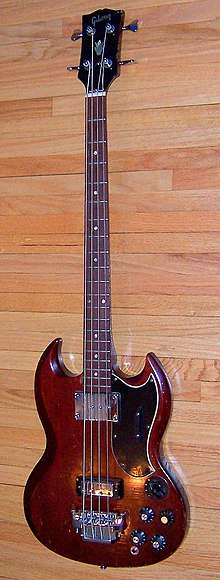Bass guitar
The bass guitar, electric bass, or simply bass, is the lowest-pitched member of the guitar family. It is a plucked string instrument similar in appearance and construction to an electric or an acoustic guitar, but with a longer neck and scale length, and typically four to six strings or courses. Since the mid-1950s, the bass guitar has largely replaced the double bass in popular music.
 | |
| String instrument | |
|---|---|
| Other names | Bass, electric bass guitar, electric bass |
| Classification | String instrument (fingered or picked; strummed) |
| Hornbostel–Sachs classification | 321.322 (Composite chordophone) |
| Inventor(s) | Paul Tutmarc, Leo Fender |
| Developed | 1930s |
| Playing range | |
 (a standard tuned 4-string bass guitar) | |
| Related instruments | |
| |
The four-string bass is usually tuned the same as the double bass, which corresponds to pitches one octave lower than the four lowest-pitched strings of a guitar (E, A, D, and G). It is played primarily with the fingers or thumb, or by striking with a pick. The electric bass guitar has pickups and must be connected to an amplifier and speaker.
Terminology
According to the New Grove Dictionary of Music and Musicians, an "Electric bass guitar [is] a Guitar, usually with four heavy strings tuned E1'–A1'–D2–G2."[1] It also defines bass as "Bass (iv). A contraction of Double bass or Electric bass guitar." According to some authors the proper term is "electric bass".[2][3] Common names for the instrument are "bass guitar", "electric bass guitar", and "electric bass"[4] and some authors claim that they are historically accurate.[5] As the electric alternative to a double bass (which is not a guitar), many manufacturers such as Fender list the instrument in the electric bass category rather than the guitar category.[6]
The bass guitar is a transposing instrument, as it is notated in bass clef an octave higher than it sounds, to reduce the need for ledger lines in music written for the instrument, and simplify reading.[7]
History
1930s
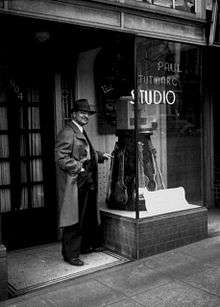
In the 1930s, musician and inventor Paul Tutmarc of Seattle, Washington, developed the first electric bass guitar in its modern form, a fretted instrument designed to be played horizontally. The 1935 sales catalog for Tutmarc's company Audiovox featured his "Model 736 Bass Fiddle", a solid-bodied electric bass guitar with four strings, a 30 1⁄2-inch (775-millimetre) scale length, and a single pickup.[8] Around 100 were made during this period.[9] Audiovox also sold their “Model 236” bass amplifier.[10]
1950s
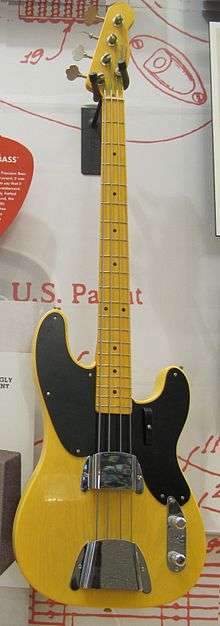
In the 1950s, Leo Fender and George Fullerton developed the first mass-produced electric bass guitar.[11] The Fender Electric Instrument Manufacturing Company began producing the Precision Bass, or P-Bass, in October 1951. The design featured a simple uncontoured "slab" body design and a single coil pickup similar to that of a Telecaster. By 1957 the Precision more closely resembled the Fender Stratocaster with the body edges beveled for comfort, and the pickup was changed to a split coil design.[12]
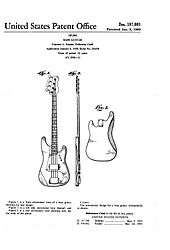
The Fender Bass was a revolutionary instrument for gigging musicians. In comparison with the large, heavy upright bass, which had been the main bass instrument in popular music from the early 20th century to the 1940s, the bass guitar could be easily transported to shows. When amplified, the bass guitar was also less prone than acoustic basses to unwanted audio feedback.[13] The addition of frets enabled bassists to play in tune more easily than on fretless acoustic or electric upright basses, and allowed guitarists to more easily transition to the instrument.[14]
In 1953, Monk Montgomery became the first bassist to tour with the Fender bass, in Lionel Hampton's postwar big band.[15] Montgomery was also possibly the first to record with the electric bass, on July 2, 1953, with the Art Farmer Septet.[16] Roy Johnson (with Lionel Hampton), and Shifty Henry (with Louis Jordan and His Tympany Five), were other early Fender bass pioneers.[11] Bill Black, who played with Elvis Presley, switched from upright bass to the Fender Precision Bass around 1957.[17] The bass guitar was intended to appeal to guitarists as well as upright bass players, and many early pioneers of the instrument, such as Carol Kaye, Joe Osborn, and Paul McCartney were originally guitarists.[13]
Also in 1953, Gibson released the first short-scale violin-shaped electric bass, with an extendable end pin so a bassist could play it upright or horizontally. Gibson renamed the bass the EB-1 in 1958. In 1958, Gibson released the maple arched-top EB-2 described in the Gibson catalog as a "hollow-body electric bass that features a Bass/Baritone pushbutton for two different tonal characteristics". In 1959, these were followed by the more conventional-looking EB-0 Bass. The EB-0 was very similar to a Gibson SG in appearance (although the earliest examples have a slab-sided body shape closer to that of the double-cutaway Les Paul Special). Whereas Fender basses had pickups mounted in positions in between the base of the neck and the top of the bridge, many of Gibson's early basses featured one humbucking pickup mounted directly against the neck pocket. The Fender and Gibson versions used bolt-on and glued-on necks.
Several other companies also began manufacturing bass guitars during the 1950s. 1956 saw the appearance at the German trade fair "Musikmesse Frankfurt" of the distinctive Höfner 500/1 violin-shaped bass, made using violin construction techniques by Walter Höfner, a second-generation violin luthier. The design became known as the "Beatle bass" for its use by Beatles bassist Paul McCartney. In 1957, Rickenbacker introduced the model 4000, the first bass to feature a neck-through-body design in which the neck is part of the body wood. Kay Musical Instrument Company began production of the K-162 in 1952, Danelectro released the Longhorn in 1956, and Burns London/Supersound in 1958.[17]
1960s
With the explosion in popularity of rock music in the 1960s, many more manufacturers began making electric basses, including Yamaha, Teisco and Guyatone. Introduced in 1960, the Fender Jazz Bass, initially known as the "Deluxe Bass", used a body design known as an offset waist which was first seen on the Jazzmaster guitar in an effort to improve comfort while playing seated.[18] The "J-bass" featured two single-coil pickups, one close to the bridge and one in the Precision bass's split coil pickup position. The earliest production Jazz basses had a pair of concentric (or "stacked") knobs to control volume and tone for each pickup; this was soon changed to the present configuration of a volume control for each pickup, and a single passive tone control.
The Jazz Bass's neck was narrower at the nut than the Precision bass — 1 1⁄2 inches (38 mm) versus 1 3⁄4 inches (44 mm) — allowing for easier access to the lower strings and an overall spacing and feel closer to that of an electric guitar, allowing trained guitarists to transition to the bass guitar more easily. Another visual difference that set the Jazz Bass apart from the Precision is its "offset-waist" body.
Pickup shapes on electric basses are often referred to as "P" or "J" pickups in reference to the visual and electrical differences between the Precision Bass and Jazz Bass pickups. In the 1950s and 1960s, all bass guitars were often called the "Fender bass", due to Fender's early dominance in the market.
Providing a more "Gibson-scale" instrument, rather than the 34 inches (864 mm) Jazz and Precision, Fender produced the Mustang Bass, a 30-inch (762 mm) scale-length instrument. The Fender VI, a 6 string bass, was tuned one octave lower than standard guitar tuning. It was released in 1961, and was briefly favored by Jack Bruce of Cream.
Gibson introduced its short-scale 30 1⁄2-inch (775 mm) EB-3 in 1961, also used by Bruce.[19] The EB-3 had a "mini-humbucker" at the bridge position. Gibson basses tended to be smaller, sleeker instruments with a shorter scale length than the Precision; Gibson did not produce a 34-inch (864 mm)-scale bass until 1963 with the release of the Thunderbird, which was also the first Gibson bass to use two humbucking pickups in a more traditional position, about halfway between the neck and bridge.
1970s

In 1971, Alembic established what became known as "boutique" or "high-end" electric bass guitars. These expensive, custom-tailored instruments, as used by Phil Lesh, Jack Casady, and Stanley Clarke, featured unique designs, premium hand-finished wood bodies, and innovative construction techniques such as multi-laminate neck-through-body construction and graphite necks. Alembic also pioneered the use of onboard electronics for pre-amplification and equalization. Active electronics increase the output of the instrument, and allow more options for controlling tonal flexibility, giving the player the ability to amplify as well as to attenuate certain frequency ranges while improving the overall frequency response (including more low-register and high-register sounds). 1973 saw the UK company Wal begin production of a their own range of active basses. In 1974 Music Man Instruments, founded by Tom Walker, Forrest White and Leo Fender, introduced the StingRay, the first widely produced bass with active (powered) electronics built into the instrument. Basses with active electronics can include a preamplifier and knobs for boosting and cutting the low and high frequencies.
In the mid-1970s, Alembic and other high-end manufacturers, such as Tobias, began offering five-string basses, with a very low "B" string. In 1975, bassist Anthony Jackson commissioned luthier Carl Thompson to build a six-string bass tuned (low to high) B0, E1, A1, D2, G2, C3, adding a low B string and a high C string.[20] These five- and six-string "extended-range basses" would become popular with session bassists, reducing the need for re-tuning to alternate detuned configurations like "drop D", and also allowing the bassist to play more notes from the same fretting position with fewer shifts up and down the fingerboard, a crucial benefit for a session player sightreading basslines at a recording session.
1980s–present

In the 1980s, bass designers continued to explore new approaches. Ned Steinberger introduced a headless bass in 1979 and continued his innovations in the 1980s, using graphite and other new materials and (in 1984) introducing the TransTrem tremolo bar. In 1982, Hans-Peter Wilfer founded Warwick, to make a European bass, as the market at the time was dominated by Asian and American basses. Their first bass was the Streamer Bass, which is similar to the Spector NS. In 1987, the Guild Guitar Corporation launched the fretless Ashbory bass, which used silicone rubber strings and a piezoelectric pickup to achieve an "upright bass" sound with a short 18-inch (457 mm) scale length. In the late 1980s, MTV's "Unplugged" show, which featured bands performing with acoustic instruments, helped to popularize hollow-bodied acoustic bass guitars amplified with piezoelectric pickups built into the bridge of the instrument.
During the 1990s, as five-string basses became more widely available and more affordable, an increasing number of bassists in genres ranging from metal to gospel began using five-string instruments for added lower range—a low "B" string. As well, onboard battery-powered electronics such as preamplifiers and equalizer circuits, which were previously only available on expensive "boutique" instruments, became increasingly available on mid-priced basses. From 2000 to the 2010s, some bass manufacturers included digital modelling circuits inside the instrument on more costly instruments to recreate tones and sounds from many models of basses (e.g., Line 6's Variax bass). A modelling bass can digitally emulate the tone and sound of many famous basses, ranging from a vintage Fender Precision to a Rickenbacker. However, as with the electric guitar, traditional "passive" bass designs, which include only pickups, tone and volume knobs (without a preamp or other electronics) remained popular. Reissued versions of vintage instruments such as the Fender Precision Bass and Fender Jazz Bass remained popular among new instrument buyers up to the 2010s. In 2011, a 60th Anniversary P-bass was introduced by Fender, along with the re-introduction of the short-scale Fender Jaguar Bass.
Fretless basses
While electric bass guitars are traditionally fretted instruments, fretless basses are used by some players to achieve different tones. Rolling Stones bassist Bill Wyman is sometimes identified as the first to make a fretless bass. In 1961, he converted a used UK-built Dallas Tuxedo bass by removing the frets and filling in the slots with wood putty.[13] Wyman used it to record songs such as "Paint It, Black" and "Mother's Little Helper" in 1966.
In 1966, Ampeg introduced the AUB-1, the first production fretless bass. Fender followed with a fretless Precision Bass in 1970. Some fretless basses have "fret line" markers inlaid in the fingerboard as a guide, while others only use guide marks on the side of the neck. In the early 1970s, fusion-jazz bassist Jaco Pastorius coated the fingerboard of his de-fretted Fender Jazz Bass in epoxy resin, allowing him to use roundwound strings for a brighter sound without damaging the fretboard.
Strings and tuning
Traditional electric bass guitars have four strings, tuned the same as double basses: E1–A1–D2–G2. However, now there are many options, with five-, six-, and more string designs, with many approaches to tuning. In addition to traditional flatwound strings, choices now include various windings and materials.
Pickups and amplification
Magnetic pickups
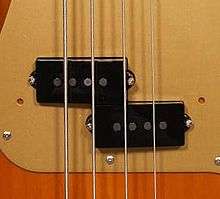
- "Precision" pickups (as introduced with the Fender Precision Bass) or "P-style" are two single-coil pickups, each offset a small amount along the length of the body so that each half is underneath two strings. The pair is considered a single pickup, as they are wired together in a humbucking configuration, greatly reducing noise from nearby electronic equipment and mains power. (Less common is the "single-coil P" pickup, as used on the original 1951 Precision bass. This is also known as the 'Vintage P' due to it being found on old vintage basses made before the invention of the split coil pickup. The "single-coil P" pickup is also used in the reissue and the Sting signature model.) P-style pickups are generally placed in the "neck" or "middle" position, but they are occasionally placed in the bridge position, or between two Jazz-style pickups.
- "Jazz" pickups (as introduced with the Fender Jazz Bass) or "J-style", are wide eight-pole pickups that lie underneath all four strings. J pickups are typically single-coil designs, though there are a large number of humbucking designs. Traditionally, two of them are used, one near the bridge and another closer to the neck. As with the halves of P-pickups, the J-type pickups are wired in a humbucking manner so that, when used together, mains noise is greatly eliminated. J-type pickups tend to have a lower output and a thinner sound than P-type pickups. Many bassists combine a 'J' pickup at the bridge and a 'P' pickup at the neck and blend the two sounds.
- Dual coil "humbucker" pickups each have two signal-producing coils. Humbuckers also produce a higher output level than single-coil pickups, though many dual-coil pickups are marketed as retrofits for single-coil designs like the J pickup and advertise a similar output and tonal character to the stock single-coils.
Non-magnetic pickups
The use of non-magnetic pickups allows bassists to use non-ferrous strings such as nylon, brass, polyurethane and silicone rubber. These materials produce different tones and, in the case of the polyurethane or silicone rubber strings, allow much shorter scale lengths.
- Piezoelectric (or "piezo") pickups (also called "piezo" pickups) use a transducer to convert vibrations in the instrument's body or bridge into an electrical signal. They are typically mounted under the bridge saddle or near the bridge and produce a different tone from magnetic pickups, often similar to that of an acoustic bass. Piezo pickups are often used in acoustic bass guitars to allow for amplification without a microphone.
- Optical pickups use an infrared LED to optically track the movement of the string, which allows them to reproduce low-frequency tones at high volumes without the "hum" or excessive resonance associated with conventional magnetic pickups. Since optical pickups do not pick up high frequencies or percussive sounds well, they are commonly paired with piezoelectric pickups to fill in the missing frequencies.
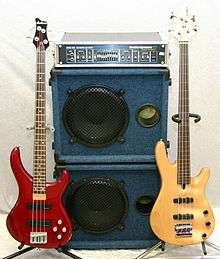
Amplification and effects
Similar to the electric guitar, the typical electric bass guitar requires an external amplifier in order to be heard in performance settings. Additionally, various electronic effects, such as preamplifiers, "stomp box"-style pedals and signal processors are available to allow for further shaping of the sound.
References
- Sadie & Tyrrell 2001.
- Wheeler 1978, pp. 101–102.
- Evans & Evans 1977, p. 342.
- Bacon, Tony; Moorhouse, Barry (1995). The Bass Book. Backbeat Books. p. Introduction. ISBN 978-1-4768-5097-9. Retrieved May 12, 2020.
- Roberts 2001, References Appendix.
- "Electric Basses | Fender". shop.fender.com. Retrieved May 12, 2020.
- Cap, Ariane (2018). Music Theory for the Bass Player: A Comprehensive and Hands-on Guide to Playing with More Confidence and Freedom. CapCat Music Media. p. 10. ISBN 978-0-9967276-3-1. Retrieved May 12, 2020.
- Blecha, Peter (December 11, 2001). "Audiovox #736: The World's First Electric Bass Guitar!". Vintage Guitar. Retrieved February 17, 2019.
- Roberts 2001, pp. 28–29.
- "Audiovox and Serenader Amps – An Interview with Bud Tutmarc". Vintage Guitar. February 19, 2002. Retrieved February 17, 2019.
- Slog & Coryat 1999, p. 154.
- Owens, Jeff (March 13, 2019). "Legendary Lows: The Precision Bass Story". www.fender.com. Retrieved January 7, 2020.
- Roberts 2001.
- Rogers, Dave; Braithwaite, Laun; May 13, Tim Mullally. "1952 Fender Precision Bass". www.premierguitar.com. Retrieved January 7, 2020.
- George 1998, p. 91.
- Mulhern, Tom (1993). Bass heroes : styles, stories & secrets of 30 great bass players : from the pages of Guitar player magazine. San Francisco: GPI Books. p. 165. ISBN 0-585-34936-3. OCLC 47008985.
- Bacon 2010.
- Owens, Jeff (June 12, 2019). "Jaco, Geddy and Flea Can't Be Wrong: The Story of the Jazz Bass". www.fender.com.
Most apparent was a feature borrowed from the Jazzmaster—an offset waist—that conveyed a sleeker and more curvaceous look to the Jazz Bass. In true Fender fashion, however, this was an innovation rooted not in form but in function—the sexier look was a by-product of the more practical consideration that the offset waist made the instrument more comfortable to play when seated, as most “serious” players of the time often were.
- Moseley, Willie G. (March 10, 2010). "The Gibson EB-3". Vintage Guitar. Retrieved September 5, 2017.
- "Partners: Anthony Jackson & Fodera Guitars".
Further reading
- Bacon, Tony (2010). 60 Years of Fender: Six Decades of the Greatest Electric Guitars. Backbeat Books. ISBN 978-0879309664.CS1 maint: ref=harv (link)
- Bacon, Tony; Moorhouse, Barry (2016). The Bass Book: A Complete Illustrated History of Bass Guitars. Backbeat Books. ISBN 978-1-4950-0150-5.CS1 maint: ref=harv (link)
- Black, J. W. (2001). The Fender Bass: An Illustrated History. Hal Leonard. ISBN 0-634-02640-2.CS1 maint: ref=harv (link)
- Boyer, Paul (2013). The Rickenbacker Electric Bass: 50 Years As Rock's Bottom. Hal Leonard. ISBN 978-1-4768-8680-0.CS1 maint: ref=harv (link)
- Evans, Tom; Evans, Mary Ann (1977). Guitars: From the Renaissance to Rock. Facts On File. ISBN 0-87196-636-0.CS1 maint: ref=harv (link)
- George, Nelson (1998). Hip Hop America. Viking Press. ISBN 978-0-670-87153-7.CS1 maint: ref=harv (link)
- Roberts, Jim (2001). How The Fender Bass Changed the World. San Francisco, California: Backbeat Books. ISBN 0-87930-630-0.CS1 maint: ref=harv (link)
- Sadie, Stanley; Tyrrell, John (2001). The New Grove Dictionary of Music and Musicians (Second ed.). London.CS1 maint: ref=harv (link)
- Slog, John J.; Coryat, Karl (1999). The Bass Player Book: Equipment, Technique, Styles and Artists. Backbeat Books. ISBN 0-87930-573-8.CS1 maint: ref=harv (link)
- Trynka, Paul (1996). Rock Hardware. Hal Leonard. ISBN 0-87930-428-6.CS1 maint: ref=harv (link)
- Wheeler, Tom (1978). The Guitar Book: A Handbook for Electric and Acoustic Guitarists. Harper & Row. ISBN 0-06-014579-X.CS1 maint: ref=harv (link)
External links
| Wikimedia Commons has media related to Bass guitars. |
| The Wikibook Guitar has a page on the topic of: Bass Guitar |
